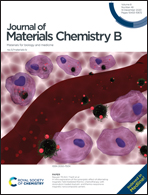Injectable zwitterionic thermosensitive hydrogels with low-protein adsorption and combined effect of photothermal-chemotherapy†
Abstract
Injectable hydrogels have been developed as biomedical materials in various fields but the biofouling on their surface limits applications in vivo. In this work, a zwitterionic structure was introduced into an injectable hydrogel based on thermosensitive nanogels to overcome the foreign body reaction. The hydrodynamic diameter of the resultant poly(N-isopropylacrylamide-co-sulfobetaine methacrylate) (PNS) nanogels was ca. 105 nm. The aqueous dispersion with a high content of PNS nanogels showed a flowable sol state at room temperature, and turned into a hydrogel in situ at ∼36 °C due to the thermosensitivity of the PNS nanogels. In particular, the resulting hydrogel exhibited lower biofouling both in vitro and in vivo in comparison with similar hydrogels without a zwitterionic structure. Polydopamine nanoparticles (PDA NPs) as a photothermal agent and an anti-tumour drug could be easily co-loaded in the injectable hydrogel. Under near-infrared (NIR) irradiation for 10 min, the temperature of the PNS system containing PDA NPs could reach ca. 38 °C. The drug release from the in situ-forming hydrogel could be accelerated by NIR laser irradiation, and showed a sustainable release behavior and adjustability. The results of intratumoral injection of the as-prepared injectable hydrogel containing PDA NPs and an anti-tumour drug showed significant anticancer effects combining photothermal therapy and local chemotherapy. This constructed injectable zwitterionic thermosensitive hydrogel is easy to use with the advantage of low-fouling and may become a promising platform for various biomedical applications.



 Please wait while we load your content...
Please wait while we load your content...